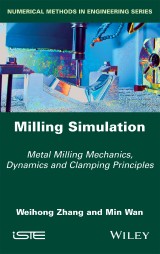Details

Milling Simulation
Metal Milling Mechanics, Dynamics and Clamping Principles1. Aufl.
|
139,99 € |
|
| Verlag: | Wiley |
| Format: | |
| Veröffentl.: | 15.06.2016 |
| ISBN/EAN: | 9781119262909 |
| Sprache: | englisch |
| Anzahl Seiten: | 272 |
DRM-geschütztes eBook, Sie benötigen z.B. Adobe Digital Editions und eine Adobe ID zum Lesen.
Beschreibungen
<p>Reliable scheduling in cutting conditions is very important in machining processes, and this requires thorough understanding of the physical behaviors of the machining process, which cannot be achieved without understanding the underlying mechanism of the processes. The book describes the mechanics and dynamics together with the clamping principles in milling processes, and can be used as a guideline for graduate students and research engineers who wish to be effective manufacture engineers and researchers.</p> <p>Many books have focused on common principles, which are suitable for general machining processes, e.g., milling, turning and drilling, etc. This book specifically aims at exploring the mechanics and dynamics of milling processes. Original theoretical derivations and new observations on static cutting force models, dynamic stability models and clamping principles associated with milling processes are classified and detailed. The book is indented as a text for graduate students and machining engineers who wish to intensively learn milling mechanism and machine tool vibration.</p>
<p>Preface ix</p> <p>Introduction xi</p> <p><b>Chapter 1 Cutting Forces in Milling Processes 1</b></p> <p>1.1 Formulations of cutting forces 1</p> <p>1.1.1 Mechanics of orthogonal cutting 1</p> <p>1.1.2 Cutting force model for a general milling cutter 4</p> <p>1.2 Milling process geometry 8</p> <p>1.2.1 Calculations of uncut chip thickness 8</p> <p>1.2.2 Determination of entry and exit angles 12</p> <p>1.3 Identification of the cutting force coefficients 24</p> <p>1.3.1 Calibration method for general end mills 24</p> <p>1.3.2 Calibration method in the frequency domain 33</p> <p>1.3.3 Calibration method involving four cutter runout parameters 39</p> <p>1.3.4 Identification of shear stress, shear angle and friction angle using milling tests 48</p> <p>1.4 Ternary cutting force model including bottom edge cutting effect 55</p> <p>1.4.1. Calculations of <b>F</b><sub>B</sub>(ϕ) 57</p> <p>1.4.2. Calculations of <b>F</b><sub>B</sub>(ϕ) 57</p> <p>1.4.3 Calibration of <i>K<sub>qc</sub></i> (<i>q = T, R</i>) 58</p> <p>1.4.4 Calibrations of <i>K<sub>q,</sub></i><sub>B </sub>(<i>q = T, R</i>) 59</p> <p>1.4.5 Experimental work 61</p> <p>1.5 Cutting force prediction in peripheral milling of a curved surface 61</p> <p>1.5.1 Calculations of instantaneous uncut chip thickness 65</p> <p>1.5.2 Calculations of entry and exit angles 67</p> <p><b>Chapter 2 Surface Accuracy in Milling Processes 71</b></p> <p>2.1 Predictions of surface form errors 71</p> <p>2.1.1 Calculation of cutting forces and process geometries 73</p> <p>2.1.2 Iterative algorithms of surface form errors 81</p> <p>2.2 Control strategy of surface form error 89</p> <p>2.2.1 Development of control strategy 89</p> <p>2.2.2 Verification of control strategy 93</p> <p>2.3 Surface topography in milling processes 95</p> <p>2.3.1 Prediction method for flat-end milling 97</p> <p>2.3.2 Prediction method for multi-axis ball end milling 101</p> <p><b>Chapter 3 Dynamics of Milling Processes 115</b></p> <p>3.1 Governing equation of the milling process 115</p> <p>3.2 Method for obtaining the frequency response function 120</p> <p>3.2.1 Derivation of calculation formulations 121</p> <p>3.2.2 Identification of model parameters 134</p> <p>3.3 Prediction of stability lobe 139</p> <p>3.3.1 Improved semi-discretization method 139</p> <p>3.3.2 Lowest envelope method 144</p> <p>3.3.3 Time-domain simulation method 155</p> <p><b>Chapter 4 Mathematical Modeling of the Workpiece-Fixture System 165</b></p> <p>4.1 Criteria of locating scheme correctness 165</p> <p>4.1.1 The DOFs constraining principle 165</p> <p>4.1.2 The locating scheme 168</p> <p>4.1.3 Judgment criteria of locating scheme correctness 172</p> <p>4.1.4 Analysis of locating scheme incorrectness 173</p> <p>4.2 Analysis of locating scheme correctness 175</p> <p>4.2.1 Localization source errors 175</p> <p>4.2.2 Fixture modeling 176</p> <p>4.2.3 Locating scheme correctness 182</p> <p>4.3 Analysis of workpiece stability 186</p> <p>4.3.1 Modeling of workpiece stability 186</p> <p>4.3.2 Solution techniques to the model of workpiece stability 194</p> <p>4.4 Modeling of the workpiece-fixture geometric default and compliance 201</p> <p>4.4.1 Source error analysis 201</p> <p>4.4.2 Workpiece position error 207</p> <p>4.4.3 Machining error analysis 212</p> <p>4.5 Optimal design of the fixture clamping sequence 218</p> <p>4.5.1 Effect of clamping sequence on high-stiffness workpiece 218</p> <p>4.5.2 Effect of clamping sequence on low-stiffness workpiece 224</p> <p>4.5.3 Optimization of clamping sequence 225</p> <p>Bibliography 229</p> <p>Index 245</p>
<strong>Weihong Zhang</strong>, Professor, School of Mechanical Engineering, Northwestern Polytechnical University, Shaanxi, People's Republic of China. <p><strong>Min Wan</strong>, Professor, School of Mechanical Engineering, Northwestern Polytechnical University, Shaanxi, People's Republic of China.

















